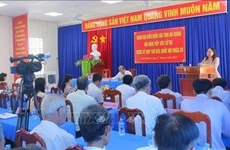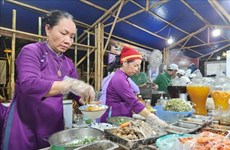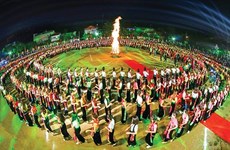Ha Giang preserves, promotes Mong people’s cultural identity
The 2023 Mong ethnic cultural festival is taking place in Meo Vac district, the northern mountainous province of Ha Giang, attracting a large number of domestic and international tourists. The annual event aims to preserve the traditional cultural values of the ethnic community in the district.
 Ha Giang province houses many ethnic groups, with Mong people forming the largest among them. (Photo: VNA)
Ha Giang province houses many ethnic groups, with Mong people forming the largest among them. (Photo: VNA)The number of Mong people in Ha Giang is nearly 200,000, accounting for over 31% of the local ethnic population. This makes the Mong people the largest ethnic group in the locality.
Consisting of two subgroups, namely Mong Trang and Mong Hoa, they reside in the northern districts of Quan Ba, Yen Minh, Dong Van, Meo Vac, as well as the western ones of Hoang Su Phi and Xin Man. The Mong people coexist with other ethnic groups such as Dao, Lo Lo, Pu Peo, Co Lao, Tay and Nung.
The community is famous for its traditional stone field cultivation, growing rice and corn. Their handicraft production, including weaving, knitting, woodworking, and forging, reaches a high level, while the traditional costumes of Mong women are very unique.
A house of the ethnic group is made of earth and consists of three compartments, with the ancestral altar placed at the middle compartment. Both the main and side doors open inward.
The traditional culture of the Mong people is a rich treasure trove of customs, rituals, beliefs, and practices. Different Mong lineages have different ways of worshipping their ancestors. Mong literature and art reflect the community's psychology, consciousness, as well as natural, social, and historical issues.
This year, the Mong ethnic cultural festival was scheduled for two days on February 4 and 5, featuring various unique activities to promote the traditional cultural beauty of the people to both local and international visitors. Visitors are set to be treated to typical dishes of the local people as well as various traditional cultural and folk sports activities that reflect the identity of the Mong ethnic people.
Within the course of the event, Meo Vac also organised a Khen Mong (panpine) festival to introduce the history of the traditional musical instrument, the ritual involving it, and a mass panpine performance of over 300 Mong artisans from various communes and towns in the district.
Its shape, structure and sounds have made the panpine unique. Notably, its sounds come through both exhalation and inhalation. Each panpine has six bamboo tubes of different lengths and widths, arranged closely together with one end connected to a gourd. The brass bar (the reed) is the only part made of metal.
Panpine gourds are usually made of pine wood, kim giao (Nageia fleuryi) and po mu (Chamaecyparis hodginsii). There are no common standards for panpine making which, however, requires ingenuity, patience and experience.
Khen is often played at Mong festivals and New Year celebrations by young Mong men who dance at the same time to show off their strength, sensibility and skills. They learn to play the musical instrument when they are small. Local boys often carry a Khen with them to terraced fields or market fairs.
At festivals, the melodies of Khen echo over mountains and forests, expressing the Mong people’s deep wishes of wellness and prosperity. Mong men who play the Khen and dance exceptionally well are admired by villagers. At funeral ceremonies, the panpine, on behalf of the livings, talks to the soul of the dead. Meanwhile, at wedding parties, it delivers the wishes of parents for the success and good health of their children./.













